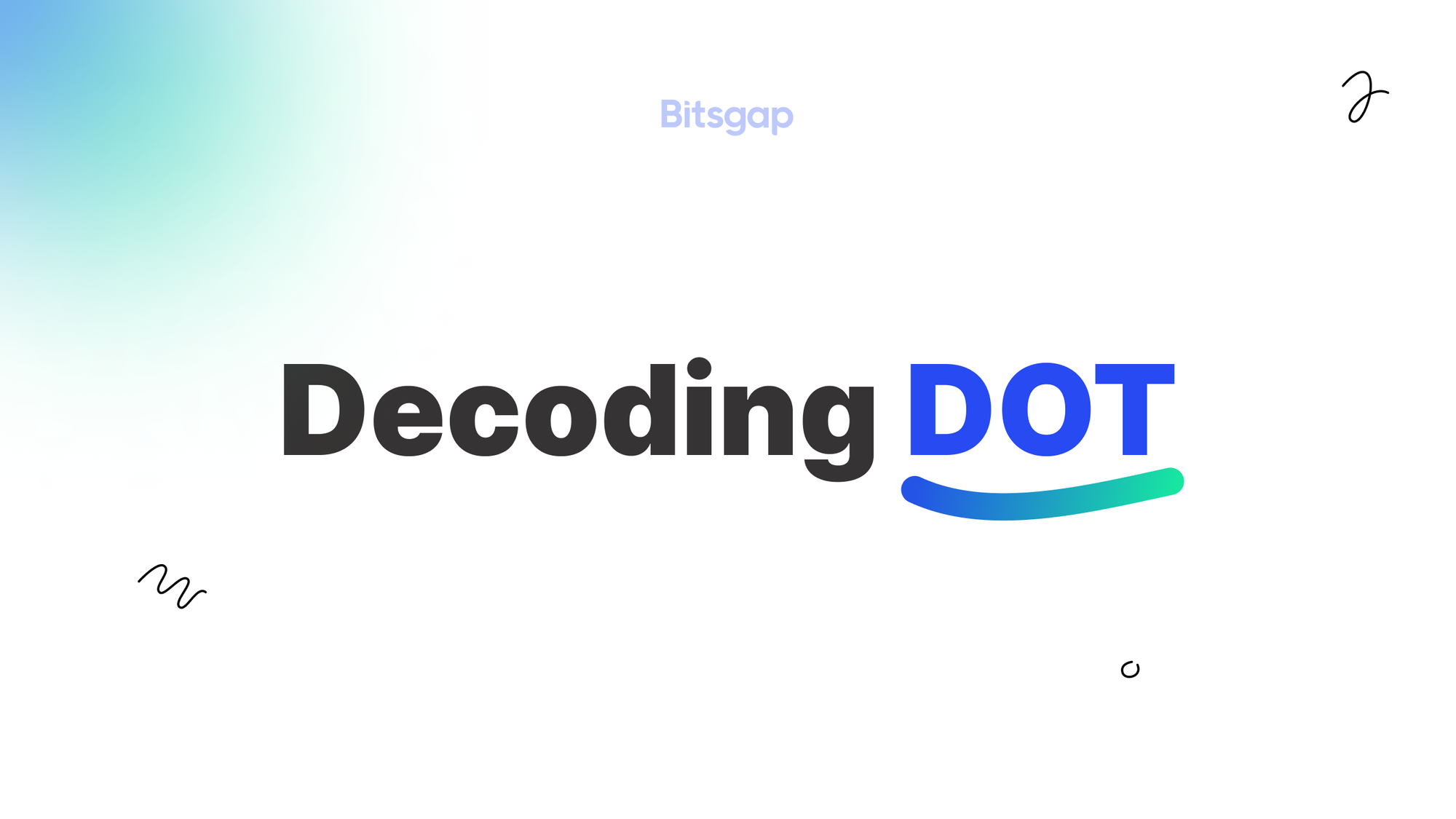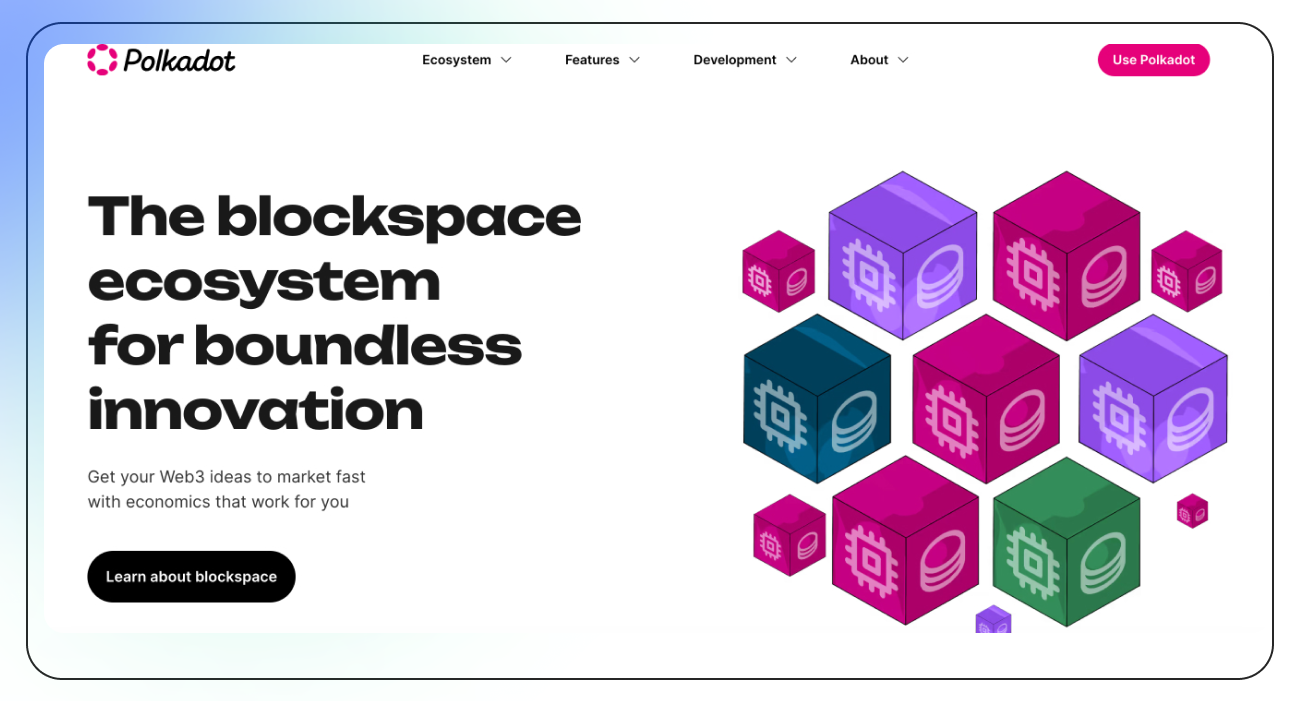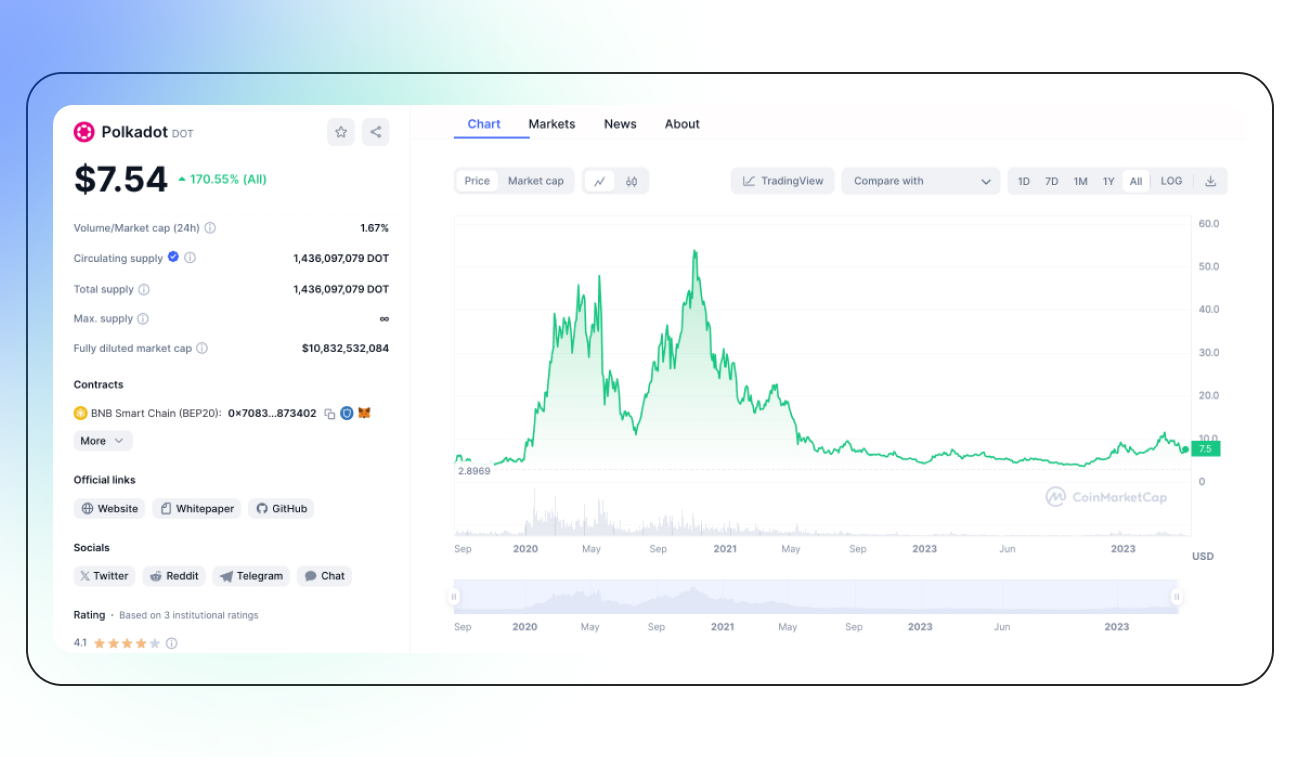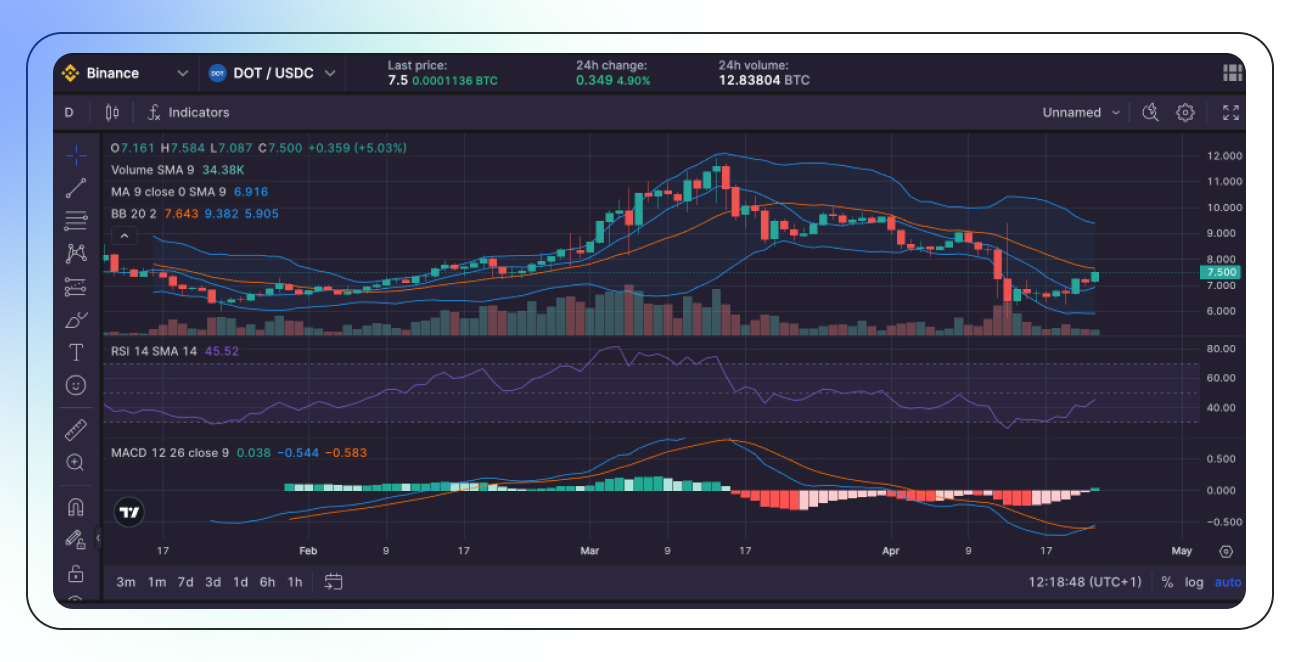
Polkadot (DOT) Analysis + Crypto News & Token Price
Polkadot has weathered storms amidst steady progress towards an ambitious vision of multi-chain interoperability — now it looks to reaccelerate into its next era of growth. Can Polkadot regain traction and carve out its niche despite volatility?
Since its quiet emergence in 2016, Polkadot has steadily built a robust ecosystem of developers and leaders to realize an ambitious vision for blockchain interoperability. After entering the top 10 cryptos in 2021, the subsequent bear market stalled momentum but work continued behind the scenes. Now, with new developments on the horizon, Polkadot aims to regain traction.
While some dub it an “Ethereum killer”, Polkadot’s founder insists it does not compete with Ethereum but rather transforms the blockchain landscape in its own right. Regardless of labels, Polkadot’s innovative multi-chain approach and resilience through crypto winters suggest considerable long-term potential.
This article will explore Polkadot in greater depth — its background, progress, tokenomics, and price history. We’ll also chart a tentative trajectory for Polkadot’s price and role amidst the capricious crypto landscape ahead.
What Is Polkadot (DOT)?

👉 Created by the non-profit Web3 Foundation and built using Parity Substrate tech, Polkadot emerged under Dr. Gavin Wood’s guidance alongside hundreds of builders. Its aspirations are no less than becoming the essential backbone for an open, decentralized internet of the future.
Polkadot is a cutting-edge blockchain platform designed to enable a completely decentralized web where users maintain control over their identities and data, free from the influence of any central authority. It facilitates the interconnectivity of a wide range of blockchains through its unique relay chain architecture, empowering various networks — both private and public, permissioned and permissionless — to communicate and transact in a trustless manner. This interoperability is a significant step towards the creation of a truly scalable multi-chain ecosystem.
👉 Consider Polkadot like the infrastructure for a massive, integrated mall allowing various specialty stores to thrive together through shared resources.
In other words, Polkadot functions as a "heterogeneous multichain system" — an infrastructure enabling a spectrum of customized blockchains to operate in conjunction. As a Layer 0 network, Polkadot furnishes interoperable foundations for Layer 1 chains to build upon without reinventing basic components. This allows developers to focus strictly on optimizing their particular blockchain's purpose. Historically, most Layer 1 chains existed in silos unable to communicate across protocols. However, Polkadot facilitates seamless data transmission between public and private chains of all kinds.
Polkadot Core Components: Chains, Parachains, and so on
Polkadot features a primary network called the Relay Chain alongside multiple parallel blockchains known as parachains. Below, we’ll explore both in more detail.
Relay Chain
The Relay Chain is the backbone of Polkadot's architecture, responsible for the network's overarching security, consensus, and cross-chain interoperability. It acts as the central connector for various network participants and ensures transaction completion.
Designed with minimal functionality, the Relay Chain does not support smart contracts directly. Instead, its main role is to facilitate the coordination and communication across the entire Polkadot system, including its parachains. This design approach allows the Relay Chain to dedicate more resources to its primary functions by delegating specific capabilities to the parachains.
Parachains
Parachains, short for parallelized chains, are individual blockchains that operate within the Polkadot ecosystem, each with its unique logic and features. These chains function autonomously, complete with their tokens and governance systems, catering to distinct use cases.
Although they operate independently, parachains leverage the Relay Chain for enhanced security and interoperability, allowing for seamless transactions. This setup lets parachain developers and users concentrate on specialized objectives, such as enhancing privacy or scalability, without compromising on security or transaction speed.
Currently, parachains must lease slots on Polkadot to be part of the network, with the architecture supporting approximately 100 slots. However, plans are in motion to increase this capacity up to 1,000 parachains and introduce more flexible, cost-effective connection methods.
👉 Imagine the Relay Chain as a robust exterior ring, with various parachains affixed like spokes to enable communication between them. By conforming to Polkadot’s standards, external chains can plug into the network for trustless data transfer. Collators submit parachain blocks to Relay Chain validators for verification, offloading consensus burdens, while Polkadot’s Cross-Consensus Messaging Format (XCM) enables universal interchain communication.
Blockspace
Gavin Wood envisions Polkadot not merely as a network of blockchains but as a versatile ecosystem supporting general blockspace, which could revolutionize how DApp developers utilize the network’s security without needing a full parachain.
In a significant roadmap update in June 2023, Wood introduced new mechanisms for allocating Polkadot’s blockspace more flexibly and efficiently, addressing the needs for expanded access during high-demand periods. This approach aims to mitigate issues like rising fees or congestion seen on other networks.
Governance and Consensus
Governance in Polkadot involves the community directly through OpenGov, introduced in June 2023, which empowers the community with full voting rights on protocol changes. This model avoids hard forks by enabling seamless updates.
The Polkadot Fellowship, part of this governance framework, consists of elected technical experts from the DOT holder community, playing a crucial role in safeguarding the network by reviewing and categorizing proposals.
For consensus, Polkadot uses a nominated proof-of-stake (NPoS) mechanism, carefully selecting validators and nominators to maximize network security.
Substrate
Substrate serves as Polkadot's robust blockchain framework, significantly simplifying the process of creating new blockchains. It is tailored to assist developers in crafting their distinct blockchains, which can seamlessly connect to the Relay Chain, benefiting from its enhanced security, speed, and efficiency. This design enables developers to concentrate on innovating within their projects rather than allocating extensive resources and finances to construct foundational infrastructure from the ground up.
All blockchains developed using Substrate are inherently compatible with Polkadot, granting them access to a broad, interoperable ecosystem of parachains, applications, and resources.
The creators of Substrate, leading figures in the blockchain industry, designed this framework to transcend the constraints associated with earlier network generations. Their goal was to provide developers with a toolkit that eliminates the need to build and fine-tune a blockchain from scratch.
While Substrate and Polkadot are synergistic, they operate independently. Parachains on Polkadot can be developed using different software frameworks other than Substrate, and chains created with Substrate aren't obliged to connect with Polkadot or its experimental network, Kusama.
Kusama
Kusama acts as Polkadot’s canary network, a staging ground for early deployments and a platform for experimentation. It serves as a live pre-production environment where developers can test their chains or decentralized applications (DApps) under real conditions to mitigate risks before their official launch on Polkadot.
Kusama presents a lower economic entry threshold compared to Polkadot, making it more accessible for launching parachains or becoming a validator with less financial requirement in terms of DOT.
Governance on Kusama is expedited compared to Polkadot, facilitating rapid testing of new features before their integration into Polkadot. Kusama’s governance cycle is markedly faster, requiring only seven days for tokenholders to vote on referendums, followed by an eight-day validation period, after which changes are implemented.
The ethos of Kusama is encapsulated in its motto, “expect chaos.” This reflects its quicker upgrade cycle, which, while enabling swift advancements, may compromise stability.
Consequently, stakeholders need to remain vigilant, keeping abreast of ongoing proposals, referendums, and updates. Validators on Kusama are also accustomed to frequent updates, often at short notice, to accommodate the network’s dynamic nature.
Polkadot (DOT) Review: Ecosystem & Tokenomics & Utility
The DOT token is the native cryptocurrency of the Polkadot network, serving as the primary means of facilitating various network operations. It is used for paying transaction fees, securing parachain slots through bonding, participating in governance decisions, and rights for validating transactions.
Communication or data exchanges between two blockchains within the network are facilitated using pre-purchased blockspace, which can be acquired either in bulk or on-demand. Additionally, protocol upgrades or amendments are voted on through the process of temporarily bonding DOT tokens.
Nominators contribute to network security by staking their DOT with a chosen validator they support. This staking mechanism not only raises the cost of potential network attacks but also enables DOT holders to accrue staking rewards in the form of new tokens.
Fig. 1. DOT’s functions.
DOT’s supply details:
- Max Supply: DOT does not have a hard cap or maximum supply, unlike some other cryptocurrencies. Instead, it has an inflationary model designed to encourage participation in the staking process. The inflation rate is designed to be approximately 10% per annum, but this can change depending on the staking ratio in the network.
- Initial Supply: At its genesis block in 2020, Polkadot had an initial supply of 10 million DOT tokens. This was before the redenomination from old DOT to new DOT in August 2020, which changed the supply by a factor of 100, resulting in the new total supply of 1 billion DOT tokens.

As of April 22, 2024, current market data (Pic.) indicates the following:
- Current price: $7.54
- Change in value: +170.55% (over all time)
- Circulating supply: 1,436,097,079 DOT
- Total supply: 1,436,097,079 DOT
- Max. supply: unlimited
- Fully diluted market cap: $10,832,532,084
Polka Dot Crypto News
Among the latest happenings, Polkadot has announced a major upgrade dubbed the Join-Accumulate Machine (JAM), which was revealed by Gavin Wood during the Token2049 crypto conference in Dubai. This upgrade aims to replace the existing Relay Chain with a more modular and minimalist design, enhancing the network's ability to run generic services and increase stability. The upgrade also introduces technical improvements such as replacing WebAssembly with the Polkadot Virtual Machine based on RISC-V ISA and incorporating SAFROLE, a SNARK-based block production algorithm.
To encourage development on the JAM protocol, a 10 million DOT prize pool has been established, aiming to foster diverse development within the Polkadot ecosystem. This initiative is part of Polkadot's strategy to decentralize further and stimulate innovation across its network.
Despite these promising developments, the DOT token has experienced some market volatility. Following the announcement of the JAM upgrade, the DOT price saw an initial increase but has struggled to maintain these gains amid broader market conditions. This reflects the complex dynamics affecting cryptocurrency prices, including investor sentiment, market trends, and macroeconomic factors.
Then, there was much talk about Polkadot 2.0, which’s said to solve the scalability and interoperability problems with a new concept called Agile Coretime — a marketplace where parachains can acquire computational "Coretime" and blockchain space "Blockspace" on-demand.
This new dynamically scalable framework would let both major applications and humble projects seamlessly join Polkadot's ecosystem by purchasing necessary resources with DOT tokens. Additionally, Asynchronous Backing would detache parachain processing from rigid block order, enabling validators to prioritize time-critical transactions independently. By liberalizing validation flows, parachain block times may decrease substantially from 12 to 6 seconds, boosting overall throughput eightfold. This sweeping upgrade promises to redefine Polkadot as it gradually rolls out through late 2024. By introducing on-demand scalability and accelerated validation, Polkadot 2.0 may cement itself as the premier hub interconnecting the blockchain ecosystem.
Polkadot Price History & Future Trajectory

The chart above (Pic. 4) displays the DOT price over a period of time spanning from September 2019 to mid-2023. The chart shows a significant peak in the asset's price around mid-2021, reaching nearly $60. However, following this peak, there is a sharp decline and the price stabilizes at a lower level, fluctuating around $10. The current price at the end of the chart is around $7.6. The trading volume appears to have spikes corresponding to the price movements, with higher volumes during periods of significant price changes.

The second chart focuses on a shorter timeframe. It shows DOT’s volatile recovery from as low as $5 with the price rising to a peak of approximately $11 before falling back down to around $7.5.
Polkadot Price Today

Based on the daily chart for DOT/USDC, we can see that the price has been in a downward trend since reaching a high of around $11.00 in early April. The price has been making lower lows and lower highs, which is a bearish signal. Currently, the price is trading just above the $7.50 level, which seems to be acting as a support. The MACD is showing a potential bullish crossover, as the signal line is about to cross above the MACD line, suggesting that the downward momentum might be losing strength. The RSI is also at a neutral level, around 45, which indicates that the price is not in the oversold or overbought territory.

The 1-hour chart shows a more volatile price movement, with the price fluctuating within a range between $7.00 and $7.50. The Bollinger Bands are squeezing, which suggests that a breakout might be imminent. The RSI is also at a neutral level, around 74, indicating that there might be room for some upward movement. The MACD is bullish as the signal line is above the MACD line, showing that there might be some buying pressure.
Overall, the technical indicators on both charts suggest that DOT's price might be consolidating before making its next move. If the price can hold above the $7.50 support level and the MACD continues to show bullish signals, we could see a potential upward movement towards the next resistance level at $8.00. However, if the price breaks below the $7.50 support level, we could see further downside movement towards the $7.00 level. Please note that this is not financial advice, and it's important to conduct your research and analysis before making any investment decisions.
Polkadot Coin Price Prediction 2030
Multiple models predict Polkadot's DOT token could surge over 300% by 2030 — but volatility makes long-term crypto forecasting complex.
The most conservative estimate from Binance sees a modest rally to $9.55. However, other analysts like CoinCodex eye a bolder 373% explosion to $34.13 as adoption expands.
Further optimistic scenarios envision DOT reaching up to $50 (CoinPedia) or even testing $60 (CryptoNewsZ) as the top end of estimated ranges before 2030.
Yet despite the promise of parachains and interoperability, inheriting the crypto market's turbulence obscures certainty. Ultimately, researching the competitive landscape and weighing risks matter more than fixating on speculative future prices. While Polkadot's vision could power significant upside, exercising caution against volatility remains critical before committing funds.
Acquiring and Storing DOT
For buying or selling DOT, highly reputable centralized exchanges like Bybit, Binance, OKX allow easy access while decentralized options such as HydraDX offer more control.
Meanwhile, platforms like Bitsgap allow trading DOT across more than 15 top centralized exchanges within a single interface. Beyond convenient consolidation, Bitsgap offers smart trading instruments and algorithmic bots to automate profitable trading strategies for DOT and other crypto around the clock. Portfolios stay synchronized across linked exchanges in real-time. By combining a comprehensive bird's eye overview of dispersed accounts with sophisticated instrumentation for enhanced performance, Bitsgap streamlines DOT management and optimizes returns simultaneously. Try—see for yourself.
As for storing DOT—there’re robust wallet options available. Leading software picks include the convenient Nova mobile and Talisman browser extension wallets.
ELLIPAL's hardware Titan wallet provides excellent long-term holding security and staking functionality. And while Ledger supports DOT itself, its wallet currently lacks Parachain capabilities.
More advanced DOT users can leverage Polkadot's native suite spanning the configurable Vault and JS UI wallets alongside the Subkey wallet.
Concluson
Polkadot's innovative multi-chain model aims to redefine blockchain interoperability and scalability, aligning with the evolving Web3 landscape. However, as an advanced platform it faces adoption hurdles common to nascent technologies, including complexity barriers and modest ecosystem activity.
Prolonged price weakness in native token DOT mirrors the broader crypto market's decline through 2022/2023. As the next bull cycle approaches, the question becomes whether the excitement surrounding Polkadot returns.
The transition to Polkadot 2.0 reflects the project's continued evolution to drive efficiency and real-world usage. Like any successful innovation, the Polkadot community understands the importance of adapting to stay relevant amid ever-advancing blockchain capabilities.
If Polkadot can leverage its architectural strengths while overcoming initial adoption challenges, it may yet fulfill a key role in realizing the vast potential of an interconnected, decentralized future. As the project matures in parallel with the broader crypto space, its trajectory remains filled with both immense promise and uncertainty.